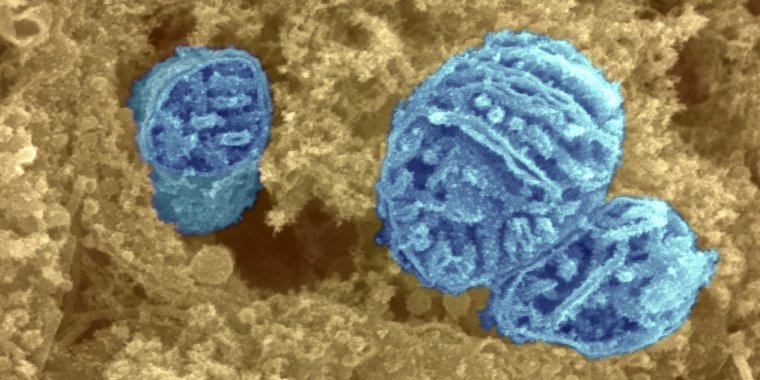| News / Science News |
Interplay between mitochondria and the nucleus may have implications for changing cell’s ‘batteries’
Matching mitochondrial DNA to nuclear DNA could be important when selecting potential donors for the recently-approved mitochondrial donation treatment, in order to prevent potential health problems later in life.

Three mitochondria surrounded by cytoplasm. Photo: Dr David Furness/Wellcome Images
Almost all of the DNA that makes up the human genome – the body’s ‘blueprint’ – is contained within our cells’ nuclei. This is referred to as ‘nuclear DNA’. Among other functions, nuclear DNA codes for the characteristics that make us individual as well as for the proteins that do most of the work in our bodies.
Our cells also contain mitochondria, often referred to as the ‘batteries’ that provide the energy for our cells to function. Each of these mitochondria is coded for by a tiny amount of ‘mitochondrial DNA’. Mitochondrial DNA makes up only 0.1% of the overall human genome and is passed down exclusively from mother to child.
Until now, scientists had thought that mitochondria were readily interchangeable, serving only to power our bodies, and so an individual’s mitochondria could be replaced with those from a donor with no consequences. However, esearchers compared mitochondrial and nuclear DNA from tens of thousands of people and found that mitochondria may be fine-tuned to the nucleus.
The researchers studied over 1,500 mother-child pairs and found that just under a half (45%) of individuals within these pairs harboured mutations affecting at least 1% of their mitochondrial DNA.
Mutations in certain parts of mitochondrial DNA were more likely to be transmitted, such as those in the so-called D-loop region, which controls how mitochondrial DNA copies itself. Conversely, mutations in other parts of mitochondrial DNA were more likely to be suppressed, such as the code for how mitochondria produce their own proteins.
Genetic variants that had previously been observed around the world were more likely to be passed on than completely new ones, the team found. This implies that there is a mechanism that filters the mitochondrial DNA when it is being passed down from mother to child, influencing the likelihood that a particular variant becomes established in the human population.
DNA can give us clues to our ancestry – for example, the pattern of genetic variants in an individual’s DNA might be more common in people of European ancestry than it is in people of Asian ancestry.
In most people, genetic variants in both our nuclear and mitochondrial DNA come from the same part of the world. However, in around one in 40 people in the UK sample, the mitochondrial DNA and nuclear DNA did not have matching ancestries. For example, the nuclear DNA could be European whilst the mitochondrial DNA is Asian. This happens because at some point in the maternal lineage, there was a mother from a different ethnic background.
There’s a subtle relationship between the mitochondria and nuclei in our cells that we’re only just starting to understand.
What this suggests to us is that swapping mitochondria might not be as straightforward as just changing the batteries in a device. (University of Cambridge)
YOU MAY ALSO LIKE



